+ Open data
Open data
- Basic information
Basic information
| Entry |  | |||||||||||||||
|---|---|---|---|---|---|---|---|---|---|---|---|---|---|---|---|---|
| Title | Structure of basal beta-arrestin2 | |||||||||||||||
 Map data Map data | ||||||||||||||||
 Sample Sample |
| |||||||||||||||
 Keywords Keywords |  GPCR / GPCR /  Arrestin / Arrestin /  SIGNALING PROTEIN / SIGNALING PROTEIN /  SIGNALING PROTEIN-IMMUNE SYSTEM complex SIGNALING PROTEIN-IMMUNE SYSTEM complex | |||||||||||||||
| Function / homology |  Function and homology information Function and homology informationtype 2A serotonin receptor binding / platelet activating factor receptor binding / postsynaptic signal transduction / positive regulation of synaptic transmission, dopaminergic /  alpha-1A adrenergic receptor binding / alpha-1A adrenergic receptor binding /  follicle-stimulating hormone receptor binding / Activation of SMO / G alpha (s) signalling events / follicle-stimulating hormone receptor binding / Activation of SMO / G alpha (s) signalling events /  alpha-1B adrenergic receptor binding / follicle-stimulating hormone signaling pathway ...type 2A serotonin receptor binding / platelet activating factor receptor binding / postsynaptic signal transduction / positive regulation of synaptic transmission, dopaminergic / alpha-1B adrenergic receptor binding / follicle-stimulating hormone signaling pathway ...type 2A serotonin receptor binding / platelet activating factor receptor binding / postsynaptic signal transduction / positive regulation of synaptic transmission, dopaminergic /  alpha-1A adrenergic receptor binding / alpha-1A adrenergic receptor binding /  follicle-stimulating hormone receptor binding / Activation of SMO / G alpha (s) signalling events / follicle-stimulating hormone receptor binding / Activation of SMO / G alpha (s) signalling events /  alpha-1B adrenergic receptor binding / follicle-stimulating hormone signaling pathway / alpha-1B adrenergic receptor binding / follicle-stimulating hormone signaling pathway /  angiotensin receptor binding / positive regulation of cardiac muscle cell differentiation / WNT5A-dependent internalization of FZD4 / angiotensin receptor binding / positive regulation of cardiac muscle cell differentiation / WNT5A-dependent internalization of FZD4 /  protein kinase B binding / MAP2K and MAPK activation / Ub-specific processing proteases / negative regulation of toll-like receptor signaling pathway / Cargo recognition for clathrin-mediated endocytosis / protein kinase B binding / MAP2K and MAPK activation / Ub-specific processing proteases / negative regulation of toll-like receptor signaling pathway / Cargo recognition for clathrin-mediated endocytosis /  Clathrin-mediated endocytosis / negative regulation of interleukin-12 production / regulation of G protein-coupled receptor signaling pathway / positive regulation of calcium ion transport / arrestin family protein binding / G protein-coupled receptor internalization / type 1 angiotensin receptor binding / adult walking behavior / Thrombin signalling through proteinase activated receptors (PARs) / mitogen-activated protein kinase binding / positive regulation of epithelial cell apoptotic process / negative regulation of natural killer cell mediated cytotoxicity / negative regulation of interleukin-1 beta production / positive regulation of DNA biosynthetic process / negative regulation of release of cytochrome c from mitochondria / detection of temperature stimulus involved in sensory perception of pain / negative regulation of smooth muscle cell apoptotic process / negative regulation of interleukin-6 production / positive regulation of receptor internalization / endocytic vesicle / negative regulation of tumor necrosis factor production / Clathrin-mediated endocytosis / negative regulation of interleukin-12 production / regulation of G protein-coupled receptor signaling pathway / positive regulation of calcium ion transport / arrestin family protein binding / G protein-coupled receptor internalization / type 1 angiotensin receptor binding / adult walking behavior / Thrombin signalling through proteinase activated receptors (PARs) / mitogen-activated protein kinase binding / positive regulation of epithelial cell apoptotic process / negative regulation of natural killer cell mediated cytotoxicity / negative regulation of interleukin-1 beta production / positive regulation of DNA biosynthetic process / negative regulation of release of cytochrome c from mitochondria / detection of temperature stimulus involved in sensory perception of pain / negative regulation of smooth muscle cell apoptotic process / negative regulation of interleukin-6 production / positive regulation of receptor internalization / endocytic vesicle / negative regulation of tumor necrosis factor production /  D1 dopamine receptor binding / positive regulation of collagen biosynthetic process / negative regulation of canonical NF-kappaB signal transduction / D1 dopamine receptor binding / positive regulation of collagen biosynthetic process / negative regulation of canonical NF-kappaB signal transduction /  clathrin-coated pit / negative regulation of protein ubiquitination / cell chemotaxis / transforming growth factor beta receptor signaling pathway / 14-3-3 protein binding / negative regulation of protein phosphorylation / G protein-coupled receptor binding / clathrin-coated pit / negative regulation of protein ubiquitination / cell chemotaxis / transforming growth factor beta receptor signaling pathway / 14-3-3 protein binding / negative regulation of protein phosphorylation / G protein-coupled receptor binding /  regulation of protein phosphorylation / modulation of chemical synaptic transmission / regulation of protein phosphorylation / modulation of chemical synaptic transmission /  receptor internalization / receptor internalization /  endocytosis / positive regulation of peptidyl-tyrosine phosphorylation / endocytosis / positive regulation of peptidyl-tyrosine phosphorylation /  protein transport / positive regulation of peptidyl-serine phosphorylation / cytoplasmic vesicle / protein transport / positive regulation of peptidyl-serine phosphorylation / cytoplasmic vesicle /  postsynaptic membrane / proteasome-mediated ubiquitin-dependent protein catabolic process / basolateral plasma membrane / negative regulation of neuron apoptotic process / postsynaptic membrane / proteasome-mediated ubiquitin-dependent protein catabolic process / basolateral plasma membrane / negative regulation of neuron apoptotic process /  dendritic spine / transcription by RNA polymerase II / positive regulation of ERK1 and ERK2 cascade / molecular adaptor activity / positive regulation of phosphatidylinositol 3-kinase/protein kinase B signal transduction / protein ubiquitination / dendritic spine / transcription by RNA polymerase II / positive regulation of ERK1 and ERK2 cascade / molecular adaptor activity / positive regulation of phosphatidylinositol 3-kinase/protein kinase B signal transduction / protein ubiquitination /  endosome / positive regulation of protein phosphorylation / G protein-coupled receptor signaling pathway / protein domain specific binding / endosome / positive regulation of protein phosphorylation / G protein-coupled receptor signaling pathway / protein domain specific binding /  signaling receptor binding / glutamatergic synapse / signaling receptor binding / glutamatergic synapse /  ubiquitin protein ligase binding / protein-containing complex binding / positive regulation of gene expression / ubiquitin protein ligase binding / protein-containing complex binding / positive regulation of gene expression /  enzyme binding / identical protein binding / enzyme binding / identical protein binding /  nucleus / nucleus /  plasma membrane / plasma membrane /  cytoplasm cytoplasmSimilarity search - Function | |||||||||||||||
| Biological species |   Rattus norvegicus (Norway rat) / Rattus norvegicus (Norway rat) /   Mus musculus (house mouse) Mus musculus (house mouse) | |||||||||||||||
| Method |  single particle reconstruction / single particle reconstruction /  cryo EM / Resolution: 3.5 Å cryo EM / Resolution: 3.5 Å | |||||||||||||||
 Authors Authors | Maharana J / Sarma P / Yadav MK / Chami M / Banerjee R / Shukla AK | |||||||||||||||
| Funding support |  India, 4 items India, 4 items
| |||||||||||||||
 Citation Citation |  Journal: Science / Year: 2024 Journal: Science / Year: 2024Title: Molecular insights into atypical modes of β-arrestin interaction with seven transmembrane receptors. Authors: Jagannath Maharana / Fumiya K Sano / Parishmita Sarma / Manish K Yadav / Longhan Duan / Tomasz M Stepniewski / Madhu Chaturvedi / Ashutosh Ranjan / Vinay Singh / Sayantan Saha / Gargi ...Authors: Jagannath Maharana / Fumiya K Sano / Parishmita Sarma / Manish K Yadav / Longhan Duan / Tomasz M Stepniewski / Madhu Chaturvedi / Ashutosh Ranjan / Vinay Singh / Sayantan Saha / Gargi Mahajan / Mohamed Chami / Wataru Shihoya / Jana Selent / Ka Young Chung / Ramanuj Banerjee / Osamu Nureki / Arun K Shukla /      Abstract: β-arrestins (βarrs) are multifunctional proteins involved in signaling and regulation of seven transmembrane receptors (7TMRs), and their interaction is driven primarily by agonist-induced receptor ...β-arrestins (βarrs) are multifunctional proteins involved in signaling and regulation of seven transmembrane receptors (7TMRs), and their interaction is driven primarily by agonist-induced receptor activation and phosphorylation. Here, we present seven cryo-electron microscopy structures of βarrs either in the basal state, activated by the muscarinic receptor subtype 2 (M2R) through its third intracellular loop, or activated by the βarr-biased decoy D6 receptor (D6R). Combined with biochemical, cellular, and biophysical experiments, these structural snapshots allow the visualization of atypical engagement of βarrs with 7TMRs and also reveal a structural transition in the carboxyl terminus of βarr2 from a β strand to an α helix upon activation by D6R. Our study provides previously unanticipated molecular insights into the structural and functional diversity encoded in 7TMR-βarr complexes with direct implications for exploring novel therapeutic avenues. | |||||||||||||||
| History |
|
- Structure visualization
Structure visualization
| Supplemental images |
|---|
- Downloads & links
Downloads & links
-EMDB archive
| Map data |  emd_36110.map.gz emd_36110.map.gz | 59.6 MB |  EMDB map data format EMDB map data format | |
|---|---|---|---|---|
| Header (meta data) |  emd-36110-v30.xml emd-36110-v30.xml emd-36110.xml emd-36110.xml | 19.3 KB 19.3 KB | Display Display |  EMDB header EMDB header |
| FSC (resolution estimation) |  emd_36110_fsc.xml emd_36110_fsc.xml | 8.4 KB | Display |  FSC data file FSC data file |
| Images |  emd_36110.png emd_36110.png | 49.3 KB | ||
| Filedesc metadata |  emd-36110.cif.gz emd-36110.cif.gz | 6.3 KB | ||
| Others |  emd_36110_half_map_1.map.gz emd_36110_half_map_1.map.gz emd_36110_half_map_2.map.gz emd_36110_half_map_2.map.gz | 59.4 MB 59.4 MB | ||
| Archive directory |  http://ftp.pdbj.org/pub/emdb/structures/EMD-36110 http://ftp.pdbj.org/pub/emdb/structures/EMD-36110 ftp://ftp.pdbj.org/pub/emdb/structures/EMD-36110 ftp://ftp.pdbj.org/pub/emdb/structures/EMD-36110 | HTTPS FTP |
-Related structure data
| Related structure data | 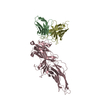 8j9kMC 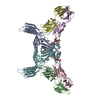 8go9C 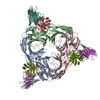 8j8rC 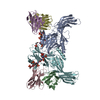 8j8vC 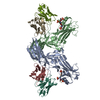 8j8zC 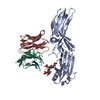 8j97C 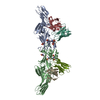 8ja3C 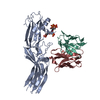 8jafC M: atomic model generated by this map C: citing same article ( |
|---|---|
| Similar structure data | Similarity search - Function & homology  F&H Search F&H Search |
- Links
Links
| EMDB pages |  EMDB (EBI/PDBe) / EMDB (EBI/PDBe) /  EMDataResource EMDataResource |
|---|---|
| Related items in Molecule of the Month |
- Map
Map
| File |  Download / File: emd_36110.map.gz / Format: CCP4 / Size: 64 MB / Type: IMAGE STORED AS FLOATING POINT NUMBER (4 BYTES) Download / File: emd_36110.map.gz / Format: CCP4 / Size: 64 MB / Type: IMAGE STORED AS FLOATING POINT NUMBER (4 BYTES) | ||||||||||||||||||||
|---|---|---|---|---|---|---|---|---|---|---|---|---|---|---|---|---|---|---|---|---|---|
| Voxel size | X=Y=Z: 1.2347 Å | ||||||||||||||||||||
| Density |
| ||||||||||||||||||||
| Symmetry | Space group: 1 | ||||||||||||||||||||
| Details | EMDB XML:
|
-Supplemental data
-Half map: #2
| File | emd_36110_half_map_1.map | ||||||||||||
|---|---|---|---|---|---|---|---|---|---|---|---|---|---|
| Projections & Slices |
| ||||||||||||
| Density Histograms |
-Half map: #1
| File | emd_36110_half_map_2.map | ||||||||||||
|---|---|---|---|---|---|---|---|---|---|---|---|---|---|
| Projections & Slices |
| ||||||||||||
| Density Histograms |
- Sample components
Sample components
-Entire : beta-arrestin2 in complex with Fab6
| Entire | Name: beta-arrestin2 in complex with Fab6 |
|---|---|
| Components |
|
-Supramolecule #1: beta-arrestin2 in complex with Fab6
| Supramolecule | Name: beta-arrestin2 in complex with Fab6 / type: complex / ID: 1 / Parent: 0 / Macromolecule list: all |
|---|
-Supramolecule #2: beta-arrestin2
| Supramolecule | Name: beta-arrestin2 / type: complex / ID: 2 / Parent: 1 / Macromolecule list: #1 |
|---|---|
| Source (natural) | Organism:   Rattus norvegicus (Norway rat) Rattus norvegicus (Norway rat) |
-Supramolecule #3: Fab6
| Supramolecule | Name: Fab6 / type: complex / ID: 3 / Parent: 1 / Macromolecule list: #2-#3 |
|---|---|
| Source (natural) | Organism:   Mus musculus (house mouse) Mus musculus (house mouse) |
-Macromolecule #1: Beta-arrestin-2
| Macromolecule | Name: Beta-arrestin-2 / type: protein_or_peptide / ID: 1 / Number of copies: 1 / Enantiomer: LEVO |
|---|---|
| Source (natural) | Organism:   Rattus norvegicus (Norway rat) Rattus norvegicus (Norway rat) |
| Molecular weight | Theoretical: 44.490906 KDa |
| Recombinant expression | Organism:   Escherichia coli (E. coli) Escherichia coli (E. coli) |
| Sequence | String: GTRVFKKSSP NCKLTVYLGK RDFVDHLDKV DPVDGVVLVD PDYLKDRKVF VTLTCAFRYG REDLDVLGLS FRKDLFIATY QAFPPMPNP PRPPTRLQDR LLKKLGQHAH PFFFTIPQNL PCSVTLQPGP EDTGKACGVD FEIRAFCAKS IEEKSHKRNS V RLIIRKVQ ...String: GTRVFKKSSP NCKLTVYLGK RDFVDHLDKV DPVDGVVLVD PDYLKDRKVF VTLTCAFRYG REDLDVLGLS FRKDLFIATY QAFPPMPNP PRPPTRLQDR LLKKLGQHAH PFFFTIPQNL PCSVTLQPGP EDTGKACGVD FEIRAFCAKS IEEKSHKRNS V RLIIRKVQ FAPETPGPQP SAETTRHFLM SDRRSLHLEA SLDKELYYHG EPLNVNVHVT NNSAKTVKKI RVSVRQYADI CL FSTAQYK CPVAQLEQDD QVSPSSTFCK VYTITPLLSD NREKRGLALD GQLKHEDTNL ASSTIVKEGA NKEVLGILVS YRV KVKLVV SRGGDVSVEL PFVLMHPKPH DHITLPRPQS APREIDIPVD TNLIEFDTNY ATDDDIVFED FARLRLK UniProtKB:  Beta-arrestin-2 Beta-arrestin-2 |
-Macromolecule #2: Fab6 light chain
| Macromolecule | Name: Fab6 light chain / type: protein_or_peptide / ID: 2 / Number of copies: 1 / Enantiomer: LEVO |
|---|---|
| Source (natural) | Organism:   Mus musculus (house mouse) Mus musculus (house mouse) |
| Molecular weight | Theoretical: 11.356607 KDa |
| Recombinant expression | Organism:   Escherichia coli (E. coli) Escherichia coli (E. coli) |
| Sequence | String: DIQMTQSPSS LSASVGDRVT ITCRASQSVS SAVAWYQQKP GKAPKLLIYS ASSLYSGVPS RFSGSRSGTD FTLTISSLQP EDFATYYCQ QSKYDGLITF GQGTKVA |
-Macromolecule #3: Fab6 heavy chain
| Macromolecule | Name: Fab6 heavy chain / type: protein_or_peptide / ID: 3 / Number of copies: 1 / Enantiomer: LEVO |
|---|---|
| Source (natural) | Organism:   Mus musculus (house mouse) Mus musculus (house mouse) |
| Molecular weight | Theoretical: 13.636962 KDa |
| Recombinant expression | Organism:   Escherichia coli (E. coli) Escherichia coli (E. coli) |
| Sequence | String: SEVQLVESGG GLVQPGGSLR LSCAASGFNF SSSYIHWVRQ APGKGLEWVA SISSYYGYTS YADSVKGRFT ISADTSKNTA YLQMNSLRA EDTAVYYCAR QGYYYNSYMQ GALDYWGQGT LVTVSS |
-Experimental details
-Structure determination
| Method |  cryo EM cryo EM |
|---|---|
 Processing Processing |  single particle reconstruction single particle reconstruction |
| Aggregation state | particle |
- Sample preparation
Sample preparation
| Buffer | pH: 7.4 |
|---|---|
| Vitrification | Cryogen name: ETHANE |
- Electron microscopy
Electron microscopy
| Microscope | TFS GLACIOS |
|---|---|
| Electron beam | Acceleration voltage: 200 kV / Electron source:  FIELD EMISSION GUN FIELD EMISSION GUN |
| Electron optics | Illumination mode: FLOOD BEAM / Imaging mode: BRIGHT FIELD Bright-field microscopy / Nominal defocus max: 2.5 µm / Nominal defocus min: 0.5 µm Bright-field microscopy / Nominal defocus max: 2.5 µm / Nominal defocus min: 0.5 µm |
| Image recording | Film or detector model: GATAN K3 (6k x 4k) / Average electron dose: 55.0 e/Å2 |
 Movie
Movie Controller
Controller


















 Z
Z Y
Y X
X



















